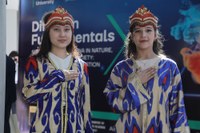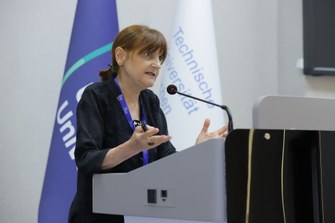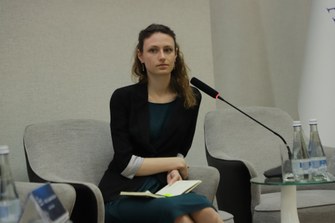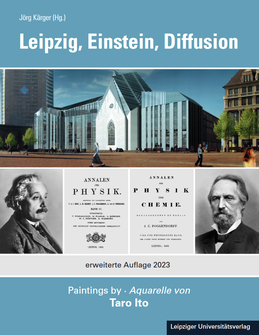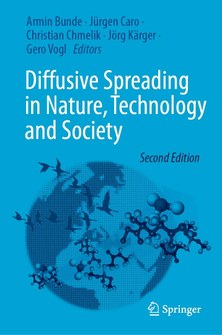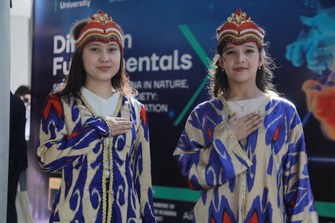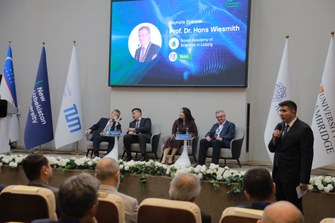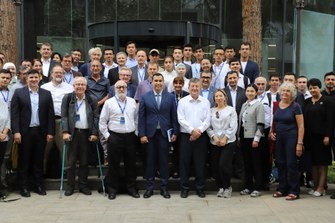The international conference series "Spreading in Nature, Technology and Society", which deals with the phenomenon of diffusion, took place for the 10th time this year—in September 2023 in Tashkent, Uzbekistan, and thus for the first time in Asia. The conference series is thus enjoying increasing popularity itself—and is now also positioning the Free State of Saxony as an attractive science location in the Central Asian region.
The series is under the auspices of the Saxon Academy of Sciences and Humanities in Leipzig, together with the University of Leipzig. Jörg Kärger, initiator of the series, gives an overview below of the history of this successful interdisciplinary academic format, which is best known under the title Diffusion Fundamentals.
by Jörg Kärger,
Retired Professor of Experimental Physics at the University of Leipzig and Member of the Saxon Academy of Sciences and Humanities in Leipzig
The phenomenon of diffusion
Spreading is an omnipresent phenomenon. It can be observed on a microscopic scale (for example when sugar dissolves in your morning coffee) as well as over macroscopic distances (such as when certain words are used) and affects both material (such as molecules or people) and immaterial objects (such as words or languages). As a synonym—and also uniformly in all languages—we speak of diffusion.
Kick-off in Leipzig
Milestones in physical diffusion research were the formulation of Fick's laws of diffusion in 1855 and the tracing back to their microscopic causes, namely Brownian motion, by Albert Einstein in his "annus mirabilis" in 1905. Both works were published in Leipzig. This made 2005 an anniversary year in diffusion research, and it made sense to hold a conference in Leipzig to mark the occasion. The two physicists Jörg Kärger from the University of Leipzig and Paul Heitjans from the University of Hanover organized the conference in close cooperation with the University of Leipzig and with researchers in Germany and abroad. The aim was to focus on the observation of spreading phenomena, their classification and their clarification not only in physics, but across disciplines.
Diffusion Fundamentals: every two years in Europe and beyond
The great success of this first conference (with over 150 participants) suggested that more should follow—then under the name Diffusion Fundamentals. Documentation on the previous biennial conferences can be found via diffusion-fundamentals.org | conferences page. The conferences are accompanied by an online journal of the same name via diffusion-fundamentals.org | journal page. In addition to the conference contributions, other papers dealing with the phenomena of diffusion will also appear here, with the editors guaranteeing peer review and publication within one month.
After L'Aquila (2007), Athens (2009), Troy, N.Y. (2011) and Leipzig again (2013), the 6th Diffusion Fundamentals Conference 2015 in Dresden was organized for the first time under the auspices of the Saxon Academy of Sciences in Leipzig, under the joint leadership of Hans Wiesmeth and Jürgen Caro. With its three classes, namely the Mathematical-Natural Sciences Class, the Philological-Historical Class and the Class of Engineering Sciences, the Academy is ideally positioned in an interdisciplinary manner and thus well suited to support the concern for interdisciplinary consideration of spreading phenomena. Initial proof of this was provided by the award of the prestigious literature prize of the Chemical Industry Fund to the book "Diffusive Spreading in Nature, Technology and Society", which emerged as a result of the Dresden conference.
Highlight to date: 10th meeting in Tashkent
The 10th meeting in Tashkent, Uzbekistan, was a particular highlight of the conference series, which thus, after Europe and the Americas, took place in Asia for the first time. The conference was chaired by Shlomo Weber. As a member of the New Uzbekistan University and a corresponding member of the Saxon Academy of Sciences, he is a central link to Tashkent.
The host New Uzbekistan University turned this anniversary event into a festive occasion. Khilola Umarova, Uzbekistan's Minister of Preschool and School Education, and Odil Abdurakhmanov, Head of the Social Development Department and Presidential Advisor for Youth, Education, Health, Culture and Sports, gave speeches during the welcoming ceremony. Bakhtiyor Yuldashev, First Vice-Rector and Vice-President for Innovation and Research at the university, also spoke at the farewell ceremony. In their words of welcome and thanks at the end of the conference, Academy President Hans Wiesmeth and Shlomo Weber emphasized the success of the conference and expressed their gratitude to the host university. The conference also marked the beginning of more intensive scientific relations with Saxony as a center of sciences and humanities. The Saxon State Ministry for Science, Culture and Tourism has now opened an office in Uzbekistan for student recruitment.
In addition, the host university provided an impressive, comprehensive photo and video documentation of the conference, which is available via diffusion-fundamentals.org | conference page 10.
Lectures at Diffusion Fundamentals in Tashkent
In her lecture on "Routes of trade and more: about the diffusion of Western art and Indian tales", Monika Zin from the Saxon Academy of Sciences and Humanities in Leipzig made direct reference to the Silk Road passing through Tashkent. This circumstance additionally motivated the organizers to dedicate this year's conference in particular to the diffusion phenomena that can be observed in society.
Further lectures were: "Diffusion of information in social networks" by Larry Blume, Cornell University, "Diffusion of socioeconomic influences across generations" by Steven Durlauf, University of Chicago, "Diffusion and acquisition of languages" by Shlomo Weber, "Movement of artifacts, people, and ideas in antiquity" by Aren M. Maeir, Bar-Ilan University, "Circular economy" by Hans Wiesmeth and a workshop on "Diffusion of and in language" led by Uwe Junghanns, University of Göttingen, and Gero Vogl, University of Vienna—both are also members of the Saxon Academy of Sciences and Humanities.
Felix Hagemeyer from the University of Leipzig also addressed the topic of spreading in society in his lecture "Interaction and exchange processes as driving forces in social development in ancient Palestine". He received the invitation to Tashkent in recognition of his nomination for the Saxon Academy of Sciences' 2023 Young Researcher Award.
Book editions and publications
The Diffusion Fundamentals anniversary conference gave rise to two book editions that were published in close connection with the conference series.
The first is the fourth edition of "Leipzig, Einstein, Diffusion" published by Leipziger Universitätsverlag, a "special kind of city guide", as Wolfgang Tiefensee (at that time Federal Minister of Transport, Building and Urban Development) wrote in his greeting to the second edition. The volume introduces the reader to the city itself as well as to the field of research in which great successes have been achieved in Leipzig. The book—written bilingually in German and English—is introduced with greetings from Sebastian Gemkow, Minister of Science of the Free State of Saxony, University Rector Eva Inés Obergfell and Academy President Hans Wiesmeth.
Also on the occasion of the jubilee conference, a new edition of the book on "Diffusive Spreading in Nature, Technology and Society", which emerged from the 2015 Dresden conference, was published, now with three chapters on the coronavirus pandemic. Accordingly, Gerhard Ertl, winner of the 2007 Nobel Prize in Chemistry, notes in his welcoming address: "The importance of this field has been underlined ... by the current worldwide pandemic spreading which seriously affected the life of all of us". Zach Evenson, Senior Editor at Springerverlag, provides an informative introduction to the book in his article "Behind the Book" in Research Communities.
Outlook for 2025
The 11th Diffusion Fundamentals Conference will take place from 30 June to 2 July 2025 at Northwestern University in Evanston, IL, one of the most prestigious universities in the USA. The conference chair is Randall Q. Snurr. He is a Corresponding Member of the Saxon Academy of Sciences and Humanities in Leipzig. Immediately following his doctorate at the University of California in Berkeley, he was a Humboldt Fellow in 1994 and 1995 and a Leibniz Professor at the University of Leipzig in 2009.
Futher images:
-
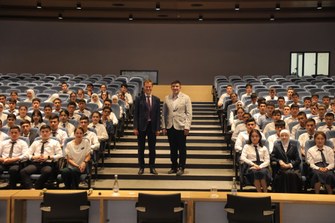
- Marc-Olivier Coppens (left) from University College London and corresponding member of the Saxon Academy of Sciences and Humanities in Leipzig, here together with Vice-Rector Ahmedov Bahodir, First Vice-President for Academic Affairs at the New Uzbekistan University. In addition to his plenary lecture, Marc-Olivier Coppens also spoke at an event to prepare for studying at the New Uzbekistan University
All pictures of the conference: New Uzbekistan University

